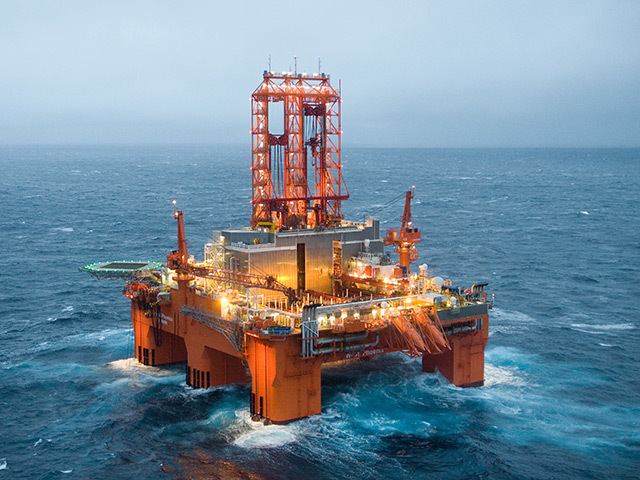
UK
At the end of August there were eight active E&A wells in the UK (6E and 2A); one in each of the West of Shetlands and Northern North Sea, two in the Southern North Sea, and four in the Central North Sea. A total of 18 E&A wells have spudded to date this year (13E and 5A), equalling the number for the whole of 2016 with four months of the year remaining.
West of Shetlands
Nexen continues drilling the Craster exploration Well 205/15-1 with the West Phoenix rig west of the Clair Field. Next in this region will be BP’s Achmelvich exploration well to the southeast of Clair.
Northern North Sea
Apache has completed operations on the Skene Northern Terrace exploration programme, with sidetrack 9/19c-S6Z completing in August. The rig, WilPhoenix, then moved a short distance to the southwest to drill appraisal Well 9/19b-22 on the Callater Field, which spudded on August 12. Statoil’s Jock Scott exploration Well 9/27-5 was abandoned around August 10 after a shorter than expected duration of just 14 days, with results pending.
Central North Sea
Maersk abandoned its Yeoman appraisal well at the end of July after one month of operations. Summit’s Ranger exploration well, drilled with Stena Spey, was abandoned around August 5 as a dry hole. Nexen’s HPHT Glengorm exploration well was re-spudded on August 4 for mechanical reasons with the Maersk Gallant. The expected duration is around 150 days, with top reservoir expected before year-end. BP’s Capercaillie exploration well, 29/4e-5, was still active at the end of August. Once finished the Paul B Loyd Junior rig will move to drill BP’s Achmelvich well west of Shetland.
Statoil moved the WilPhoenix from Jock Scott to drill Well 20/5b-13 on the Verbier Prospect, its third and final well in this campaign. This spudded on August 13 and with resources of 162mmboe, is one of several high impact wells in the UK this year. Two days later another high impact exploration well was spudded by Azinor on its Partridge Prospect in Block 14/11a. The Ocean Guardian rig is on a three well campaign for Azinor and following Partridge will drill an appraisal well on Agar before sidetracking into the Plantain Prospect in the Northern North Sea.
Southern North Sea
Wintershall is drilling an appraisal well on the Winchelsea Discovery that was made in 2016. Resources are estimated at 150 bcf, and positive results could lead to a tie-back development via the operator’s nearby Wingate Field. The most recent well to spud in the UK is Oranje Nassau’s South Sean exploration well, 49/25b-11. The Prospector 1 is targeting potential in the Rotliegendes which can be tied back to the operator’s adjacent Sean Field. The glut of new wells seen in the past two months is expected to abate in September. Westwood Global expects a total of 20 – 22 wells to be drilled in 2017, a small improvement on 2016. Positive results have been few and far between so far with the only commercial find of the year appearing to be TAQA’s Sturgeon exploration well which completed in February.
NORWAY
August recorded the highest number of exploration well spuds in a month for 2017, with four, whilst two appraisal wells have also spudded. This takes the E&A total to 19, four less than at this point in 2016. August also saw the completion of five wells, leaving three active wells at month’s end, of which one is an exploration well targeting the Goanna Prospect in the North Sea.
North Sea
Aker BP spudded exploration Well 25/4-11, targeting the Hyrokkin Prospect, on August 11, about 12km northwest of the Vilje Field. The well was plugged and abandoned as dry on August 23 before the Maersk Interceptor mobilised to spud another Aker BP operated well, 25/2-19 commencing on August 26 and is appraising the Delta structure at the Frigg Gamma Delta Discovery. Wellesley spudded its first operated well, 33/9-22, with the Deepsea Bergen, also on August 26.
Norwegian Sea
On August 2, Statoil spudded near field exploration well, 6507/8-9, within the Carmen Prospect. The well, drilled using the Deepsea Bergen, encountered a c.80m gas column within the primary reservoir and is estimated to contain c. 34.5 bcf of gas. The well was plugged and abandoned as a minor gas discovery on August 25. Development options are being considered.
Barents Sea
Statoil operated Well 7325/4-1 made a discovery at Gemini North, having encountered a 19m gas column in good reservoir quality sands of the Stø Formation and a 5m oil column in poor reservoir quality Snadd Formation. Statoil announced that the discovery was non-commercial.
After the completion of the well on August 3, Statoil mobilised the Songa Enabler and spudded its much-anticipated Korpfjell well, 7435/12-1, on August 8. The well encountered a 34m gas column with good to very good reservoir quality.
While preliminary estimates suggest the discovery contains between 212 and 424 bcf of gas, given its location, Korpfjell has been classified as a non-commercial gas discovery.
Recommended for you
